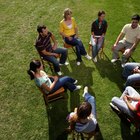
Steve Debenport/E+/Getty Images
Family therapy offers the opportunity to work through conflicts, brainstorm solutions and learn more about differences. Strategic family therapy is a fast-paced therapy model that addresses specific problems the family may be facing in a shorter time frame or brief number of sessions. Techniques during therapy sessions can teach each family member how to process emotions and work together.
Plan and Collaborate
A busy household demands organization, but when each person has a different goal in mind, conflicts arise. Come to a solution quickly by hosting a planning session during family therapy to coordinate schedules while also allocating specific times for family activities. For example, children can make a list of trips or fun activities while parents outline household responsibilities. The family can create a calendar that includes accomplishing chores and responsibilities while etching in family activities, such as catching a movie, working on an art project together or making a meal as a group. Compiling the calendar fosters a level of respect and provides an immediate solution to conflicts.
Problem Solve Together
Problems inevitably occur in any family but you can prevent them from escalating. Families need the tools and resources to solve problems peacefully. Clear the air with a problem-solving session, but first you must establish some ground rules for the exercise to ensure it is fair, civil and ultimately productive. Rules can include: discuss only one problem at a time (stay on-topic); no yelling or degrading language; take turns at talking; and express your feelings. First, the family must define the specific problem and express why it is a problem for each individual. Next, explore possible solutions together. This phase may result in disagreements but by presenting multiple options and following the rules, families have the opportunity to compromise.
Play as a Group
Use art and play-based activities during a counseling session to work through issues of resentment, isolation and loneliness. Play-based activities involving imagination, spontaneity and creativity are part of a strategic family therapy technique that helps children express themselves in ways that are already familiar to them. It can also encourage adults to express thoughts and feelings in a gentler way than traditional "talk therapy." Examples of arts and play-based exercises including building with blocks collaboratively, constructing a clay fixture or drawing a family portrait with each person adding to the project. Working as a team teaches patience and highlights the strengths of each family member while involving each person in the task.
Question and Answer
Launch a question and answer game to identify feelings about a specific challenge faced recently. Create a list of interesting questions, such as “How do you prefer to handle conflict?” and “If you could be a superhero, who would it be and why?” Include questions that focus on both emotions and creativity so family members can connect on both a fun and serious level. It's important that every family member answer the same question in turn. This way, everyone gets an equal chance to express their thoughts and feelings, and to be heard by everyone else in the family. Once the general questions have been answered, concentrate on a specific problem the family faces. Narrow the questions to focus on the issue.
Related Articles

Team Building Activities for Family ...

Similarities and Differences Between ...

The Advantages of Communication With ...

Family Conflict Examples

Caregiver Support Group Discussion ...

Communication in Family Conflicts

A Lack of Communication in the Family

How to Handle a Type A Personality

How to Deal With Strained Relationships ...

How to Mediate a Family Conflict

How to Deal With a Crisis in Your Family

How to Plan Fun Activities for Kids

How to Repair Broken Family Ties

How to Manage Conflict Through ...

Counseling Techniques With Children

How to Handle Seeing an Adult Sibling ...

How to Explain Family Dynamics

How to Conduct a Family Therapy Session

Solution-Focused Family Therapy

The Effects of Lack of Communication in ...
References
Resources
Writer Bio
Shannon Philpott has been a writer since 1999. She has experience as a newspaper reporter, magazine writer and online copywriter. Philpott has published articles in St. Louis metro newspapers, "Woman's World" magazine, "CollegeBound Teen" magazine and on e-commerce websites, and also teaches college journalism and English. She holds a Master of Arts in English from Southern Illinois University.
Photo Credits
Steve Debenport/E+/Getty Images